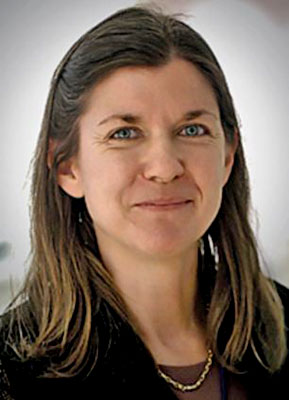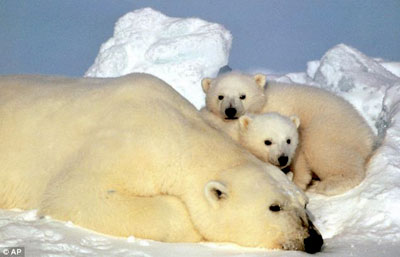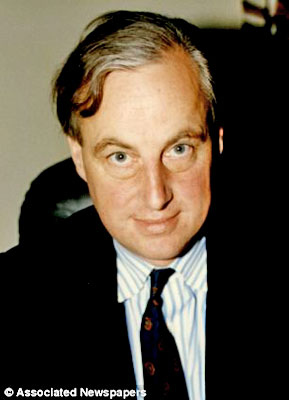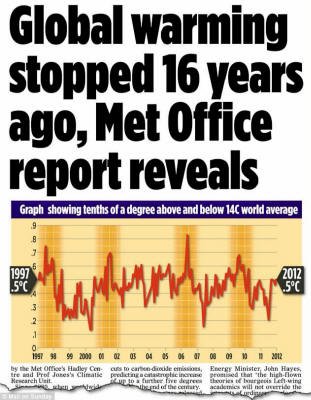Q - Is the world warming or not?

Expert Judith Curry
A - The Hadcrut 4 figures that show
a ‘pause’ in warming lasting nearly 16 years are drawn from more
than 3,000 measuring stations on land and at sea.
Hadcrut 4 is
one of several similar global databases that reveal the same
thing: that since January 1997 there has been no statistically
significant warming of the Earth’s surface.
Between 1980 and the end of 1996, the planet warmed at a rate
close to 0.2 degrees per decade. Since then, says the Met
Office, the trend has been a much lower 0.03 degrees per decade.
However, world average temperature measurements are subject to
an error of plus or minus 0.1 degrees, while any attempt to
calculate a trend for the period 1997-2012 has an in-built
statistical error of plus or minus 0.4 degrees.
The claim that
there has been any statistically significant warming for the
past 16 years is therefore unsustainable.
Q - Why does it matter if the world is
warming or not?
A - For years, the Government’s energy and climate policy has
been dominated by the belief that we need swift, drastic and
expensive reductions in carbon dioxide emissions to avert
imminent catastrophe.
In September, The Guardian claimed there
were,
‘less than 50 months to avoid climate disaster’.
These fears are based on computer models that show temperatures
continuing to rise in step with levels of CO2.
The 2007 Fourth Assessment Report of the UN Inter-governmental
Panel on Climate Change (IPCC) said:
‘For the next two decades,
a warming of about 0.2 degrees Celsius per decade is projected
for a range of emission scenarios’ - a prediction it said was
solid because this rate of increase was already being observed.
But while CO2 levels have continued to rise since 1997, warming
has paused.
This leads Prof Curry to say the IPCC’s models are
‘incomplete’, because they do not adequately account for natural
factors such as long-term ocean temperature cycles and a decline
in solar output, which have suppressed the warming effects of
CO2.
The Met Office and the CRU’s Professor Phil Jones say a
‘plateau’ of between 15 and 17 years is to be expected. But if
the warming does not start again soon, the models will be open
to challenge.
Q - Did The Mail on Sunday ‘cherry-pick’ data
to disguise an underlying warming trend?
A - Some critics claim this newspaper misled readers by choosing
start and end dates that hide the continued warming.
In fact, we looked at the period since 1997 because that’s when
the previous warming trend stopped, and our graph ended in
August 2012 because that is the last month for which Hadcrut 4
figures were available.
In April, the Met Office released figures up to the end of 2010
- an extremely warm year - which meant it was able to say there
had been a statistically significant warming trend after 1997,
albeit a very small one.
However, 2011 and 2012 so far have been
much cooler, meaning the trend has disappeared.
This may explain
why the updated figures were issued last week without a media
fanfare.

We need an energy strategy for both the short and long term
to
save the polar bear, a species whose plight is often
a symbol of
global warming
Q - But isn’t it true that the science is
‘settled’?
A - Some scientists say the pause is illusory - if you strip out
the effects of
El Niño (when the South Pacific gets
unpredictably warmer by several degrees), and
La Niña (its cold
counterpart), the underlying warming trend remains. Both
phenomena have a huge impact on world weather.
Other experts point out one of the biggest natural factors
behind the plateau is the fact that in 2008 the temperature
cycle in the Pacific flipped from ‘warm mode’, in which it had
been locked for the previous 40 years, to ‘cold mode’, meaning
surface water temperatures fell.
A cold Pacific cycle causes
fewer and weaker El Niños, and more, stronger La Niñas.
Prof Curry said that stripping out these phenomena made ‘no
physical sense’. She added that natural phenomena and the CO2
greenhouse effect interact with each other, and cannot
meaningfully be separated. It’s not just that the ‘cold mode’
has partly caused the plateau.
According to Prof Curry and others, the previous warm Pacific
cycle and other natural factors, such as a high solar output,
accounted for some of the warming seen before 1997 - some say at
least half of it.
Other scientists say that heat has somehow been absorbed by the
waters deep in the oceans. However, the evidence for this is
contested, and there are no historical records with which to
compare recent deepwater readings.
In the wake of the pause, the scientific ‘consensus’ looks much
less settled than it did a few years ago.
Q - When will warming start again?

Tim Yeo has a
significant personal stake
in the renewable energy industry
A - The truth is no one knows. It is
likely that in the 2020s, the Atlantic cycle - currently in warm
mode - will also flip to cold, so that for some years both the
Pacific and Atlantic cycles will be cold at the same time.
When this happens, world
temperatures may decline, as they did in the Forties.
Prof Curry said:
‘If we are currently in a
plateau and possibly headed for cooling, then sometime in
the middle of the century we would likely see another period
with a large warming trend.’
She added:
‘Because of natural variability,
it is impossible to pinpoint what 2100 would look like. The
climate sensitivity to greenhouse warming is still pretty
uncertain, and it is not clear whether or to what extent
man-made factors will dominate the climate of this period.’
For the world to be two degrees
warmer in 2100 than it is now - as the IPCC has predicted -
warming would not only have to restart but also proceed much
faster than it has before.
Since 1880, temperatures have risen by around 0.75 degrees.
Q - But isn’t the world still much warmer
than at any time in recorded history?
A - Ever since it was published on the cover of the IPCC’s Third
Assessment report in 2001,
the ‘hockey stick’ graph showing
stable or declining temperatures since the year 1000, followed
by a steep rise in the 20th Century, has been controversial.
There were no thermometers in 1000, so scientists use ‘proxy’
data from items such as tree rings, lake sediments and ice
cores.
The hockey stick authors have also been accused of eliminating
the ‘medieval warm period’ (MWP) at the end of the first
millennium.
Two new separate peer-reviewed studies, published in prestigious
academic journals last week, reinstated it.
The first study, led
by Bo Christiansen of the Danish Meteorological Institute,
concluded:
‘The level of warmth during the peak of the MWP in
the second half of the 10th Century, equaled or slightly
exceeded the mid-20th Century warming.’
There was also a pronounced warming period in Roman times.
Q - So where does that leave us?
A - Despite The Guardian’s bold claim that we have ‘50 months to
save the world’, other evidence suggests that there are still
decades left in which to plan an energy strategy driven by
something other than panic.
In Britain, in the short to medium term, that would mean
building modern ‘dual cycle’ gas power stations, which produce
very clean energy and, unlike inefficient wind turbines, do not
require subsidies to be economic.
In the longer term, we could be investing heavily in research
into new forms of zero-carbon power, such as nuclear fusion,
which are much closer to reality than most people realize.
Q - Surely we can leave it to our elected
representatives to research all the arguments thoroughly and
then act accordingly with our taxes?
A - Tim Yeo is the chairman of the Commons Select Committee on
Energy and Climate Change, which advises the Government on
energy policy.
Lord Deben is chairman of the
Government Climate
Change Committee, which also gives direct advice on emissions
targets.
Both Mr Yeo and Lord Deben have significant personal stakes in
the ‘renewable’ energy industry, which benefits to the tune of
billions of pounds a year from wind subsidies.




